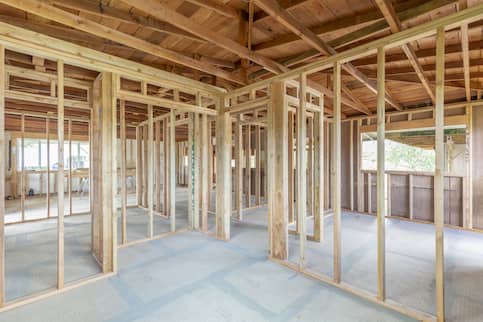Home Affordability Calculator: How Much House Can I Afford?
Whether you’re a first-time home buyer or considering selling your current home to buy a new one, you may wonder how much house you can realistically afford. Let us do the math for you. Enter your financial details, including income and debts, into our home affordability calculator to see how much home you could fit into your budget.
Payment information is not a determination of eligibility. This calculator is provided for estimation purposes only, and is based on your self-reported information and aggregate national averages.
What You’ll Need For Our Calculator
To estimate your mortgage payment, enter your:
- Annual household income. This is your total annual household income before taxes and deductions.
- Monthly debt. Total up your monthly minimum payments for all your debts, including credit cards, personal loans and student loans. This figure is used to calculate your back-end debt-to-income ratio. The lower your DTI ratio, the more room you have in your budget.
- Down payment. This is the amount you plan to pay upfront to buy a home. A higher down payment can help you secure a lower interest rate. On a conventional loan, a down payment of at least 20% of the purchase price lets you avoid paying for private mortgage insurance. How much you can put toward a down payment also may determine which loan types you can qualify for.
- State. Entering the state where you expect to buy a home lets the calculator estimate your property taxes.
- Interest rate. This is the interest rate you expect to pay on the loan. You can enter the current market rate for the type of loan you expect to get, or you can enter a specific rate if you have a mortgage preapproval or a rate lock on a loan offer.
- Property tax rate. This is prefilled based on the state where you’re looking to buy a home. The amount you can expect to pay in property taxes is included in your monthly payment breakdown.
Entering additional details will let the calculator deliver a more detailed estimate of how much house you can afford:
- Loan term. How long you will take to repay your mortgage, usually 15 or 30 years.
- PMI. Estimated monthly fee for private mortgage insurance. You only pay PMI if your down payment is less than 20% on a conventional loan. If that applies to you, enter the amount of PMI you expect to pay, which is typically $30 to $70 per month for every $100,000 borrowed.
- HOA fees. If the home you’re buying is part of a homeowners association, you’ll need to pay monthly dues.
- Homeowners insurance. Mortgage lenders require borrowers to have homeowners insurance. If you have an estimate or quote on insurance policies in the area you’re looking to buy, you can enter the monthly cost.
Take The First Step To Buying a Home
Find a lender that will work with your unique financial situation.
How The Calculator Works
Using the information you enter, the calculator estimates the price of the home you could afford to buy, starting with a 36% DTI ratio. Adjusting the slider changes how much monthly income you’re putting toward your mortgage payment and modifies the home price you could afford. It helps you decide whether spending more or less per month on a home would fit comfortably into your budget.
How Income Helps Decide How Much Home You Can Afford
Whether you earn an annual salary, hourly wages, commissions or investment income, or are self-employed or a seasonal worker, how much home you can afford will be based on your annual gross income. Your lender will want proof of your income over the past two years to ensure it’s consistent and sustainable.
Dividing your annual gross income by 12 calculates your gross monthly income, which lenders use to determine how much you can afford for a monthly mortgage payment.
The 28/36 Rule
Most lenders calculate your DTI ratios and apply what’s known as the 28/36 rule. This general rule of thumb suggests that:
- Your front-end DTI ratio, comparing your gross monthly income to your mortgage payment, shouldn’t exceed 28%.
- Your back-end DTI ratio, comparing your gross monthly income to all your monthly debt payments, shouldn’t exceed 36%.
While there may be some flexibility when applying the 28/36 rule, it generally helps prevent home buyers from taking on a mortgage that could exceed their finances.
The calculator uses your back-end DTI ratio and sets it by default to 36%.
How Loan Terms Can Affect Your Home Affordability Calculation
The terms of your mortgage significantly affect the monthly payment and how much home you can afford. A couple of the most important terms include:
- Length of loan. Most mortgages are repaid over 30 years. If you take out a loan with a shorter term – 15 years is a common alternative – the monthly payment will be higher, and you may not be able to afford as much home.
- Interest rate. Your mortgage interest rate affects your monthly payment and how much interest you pay over the life of the loan. A higher interest rate increases the monthly payment and makes the loan more expensive.
How Interest Rate Types Can Affect Your Home Affordability Calculation
The type of interest rate you choose may affect how much home you can afford:
- Fixed-rate mortgage. A fixed-rate mortgage sets a constant interest rate for the life of your loan. Your monthly principal and interest payments will not change from the first payment to the last.
- Adjustable-rate mortgage. An ARM usually locks in an interest rate lower than the rate on a similar fixed-rate loan for a set introductory period, which typically lasts three to 10 years. After that, the interest rate on your ARM will adjust at specified intervals – usually once a year – based on market interest rates. If interest rates go up, your monthly payment will, too. If rates go down, so will your monthly payment.
How Government-Backed Loans Can Affect How Much Home You Can Afford
Eligible home buyers with lower credit scores or smaller down payments may qualify for a government-backed loan to buy a home. However, these loans have additional costs that can affect your home affordability calculations.
FHA Loans
Federal Housing Administration loans have a minimum 3.5% down payment, typically allow you to qualify with a lower credit score, and have lower borrowing limits than conventional loans. FHA home buyers must pay a one-time, upfront mortgage insurance premium as well as an annual mortgage insurance premium over the life of the loan. The premiums can add to the initial cost of the home and the monthly mortgage payment.
VA Loans
Veterans Affairs loans offer many advantages for qualifying active-duty military service members, veterans and their surviving spouses, including the possibility of buying a home with no money down. While eligible buyers typically pay less for their homes, they usually pay an upfront VA funding fee that can add to the home’s cost.
USDA Loans
U.S. Department of Agriculture loans allow borrowers to buy homes in specific rural areas with no down payment. Home buyers must pay upfront and annual loan guarantee fees, which add to a home’s cost.
How Location Affects Home Price Affordability
Location affects how much home you can afford. Depending on where you live, you should consider the following:
- Cost of living. In higher-cost areas, expect to find home prices significantly above average. While some high-cost areas may have higher borrowing limits, a home likely still would be less affordable.
- Property taxes. States and counties set residential property tax rates, which can add hundreds to your monthly mortgage payment.
Home Affordability Considerations For First-Time Buyers
As a first-time home buyer, you may want to know if there are resources available to help you afford a home. Fortunately, many first-time home buyer programs offer grants and affordable loans to help you make a down payment and pay closing costs. These programs usually are available through your state’s housing finance authority.
What Other Factors Affect Home Affordability?
When considering whether you can afford a home, think about how owning a home aligns with your goals. If you expect to move to take a new job, you’ll want to understand what’s required to sell your home. If you plan to change careers, assess whether you’ll have enough consistent income to afford a monthly mortgage payment. If you’re planning family additions, consider the home’s location and size.
In addition, you’ll want to consider how the expenses of owning a home affect your ability to prepare an emergency fund and save for retirement.
How To Improve Your Ability To Afford A Home
If your calculations are coming up short, there are ways to improve your ability to afford a home:
- Adjust your expectations. Depending on where you’re looking to buy a home, you may need to consider a less expensive home or a starter home that fits your current budget.
- Increase your income. If possible, look for ways to increase your income, such as asking for a raise at work or taking on a side hustle. Keep in mind that lenders will want to see that you can sustain the additional income over time before considering it in your mortgage application.
- Build your credit score. Increasing your credit score can help lower your interest rate, which can improve your ability to afford a home. You may be able to do this on your own or with the assistance of a credit counselor. If necessary, you may want to consider buying with a co-signer or co-borrower whose credit score can help boost yours.
- Save for a larger down payment. A larger down payment can help you get a lower interest rate and help remove additional costs like mortgage insurance. If this is difficult, you may want to look for grant programs or ask a family member for a tax-free gift.
Frequently Asked Questions
Have more questions about home affordability? We have answers.
More Calculators
Use our toolbox of calculators to take the guesswork out of your home budget. We factor in all the variables so you don’t have to.





